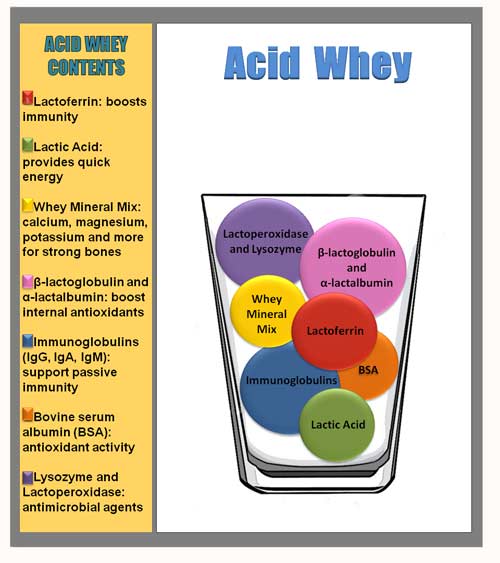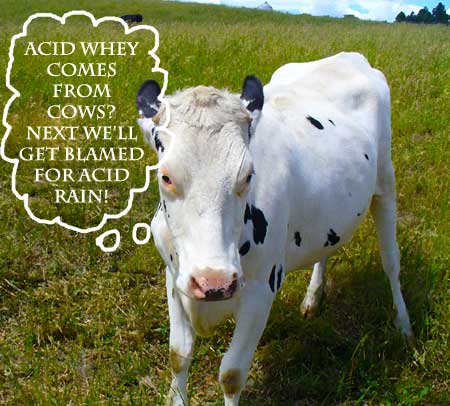Acid Whey: Healthy Super Food NOT Supervillain
Acid whey has been villainized as the bad boy of Greek yogurt production. Sadly acid whey suffers from an image problem due to its name. No one tries to talk smack about sweet whey! Far from being toxic, acid acid is a valuable and nutritious food with many health benefits.
Acid whey contains many healthy compounds:
Lactoferrin: this important component of acid whey is a valuable immune booster. Lactoferrin has antiviral, antimicrobial, anti-inflammatory and anticancer properties (Rodrigues et al. 2009, Kanwar and Kanwar 2013). Lactic acid: the lactic acid in acid whey provides quick energy, restores glycogen and prevents muscle soreness (Bergman et al. 2000, Brooks 2002, Gladden 2008, Cruz et al. 2012). For more on the health benefits and history of lactate see lactic acid myths. Whey mineral mix: calcium, magnesium and potassium are whey minerals vital for strong bones and maintaining electrolyte balance. Check out our chart on vital electrolytes found in dairy products. Beta-lactoglobulin and alpha-lactalbumin: these two whey proteins may help prevent cancer (Sternhagen and Allen 2001, Thompson et al. 1992) and boost glutathione (antioxidant) concentrations. Immunoglobulins (IgG, IgA, IgM): these acid whey immune factors that support disease control through passive immunity (Hurley and Theil 2011). Bovine serum albumin (BSA): a whey protein that inhibits tumour growth (Laursen et al. 1990) and increases antioxidant activity. Lysozyme and lactoperoxidase: these acid whey enzymes act as mild antiseptic and antibacterial agents which combat plaque, cavities and gingivitis. Lysozyme and lactoferrin work together in the stomach to kill both gram-negative and gram-positive bacteria (Sherman 2013). Lactoperoxidase is a natural bio-preservative which can extend the shelf life of foods such as fresh fish (Jasour et al. 2014).
Fun Facts:
Acid whey supports gut health in rats
Acid whey supports gut health and prevents weight gain in rats fed an unhealthy diet (Wronkowska et al. 2017). In this study, rats were fed an unhealthy atherogenic diet supplemented with cholic acid to disrupt the healthy composition of bacteria in the gut. In addition, rats received either plain bread or bread made with 20% acid whey.
The acid whey supplemented bread helped the rats overcome an unhealthy diet by promoting a healthy gut environment. This was shown by a heavier small intestine, a higher proportion of good bifidobacteria, and more short chain fatty acids produced by healthy bacteria. The rats who ate acid whey bread also gained less weight than the rats who ate normal bread.
Acid whey is high in nutrients:
Acid whey contains approximately twice as much calcium as sweet whey (Carvalho et al. 2013). Acid whey is also a very good source of riboflavin, calcium, phosphorous, thiamin, B12, pantothenic acid, zinc, potassium, magnesium and selenium.
Check here for more on the health benefits of whey!
References:
Bergman BC, Horning MA, Casazza GA, Wolfel EE, Butterfield GE, Brooks GA. Endurance training increases gluconeogenesis during rest and exercise in men. American Journal of Physiology. 2000;278:E244–E251. Pubmed. Full paper. Brooks GA. Lactate shuttles in nature. Biochemical Society Transactions. 2002;30:258–264. Pubmed. Carvalho F, Prazeres AR, Rivas J. Cheese whey wastewater: Characterization and treatment. Science of the Environment. 2013;445-446:385-396. doi: 10.1016/j.scitotenv.2012.12.038. Pubmed Cruz RS, de Aguiar RA, Turnes T, Penteado Dos Santos R, de Oliveira MF, Caputo F. Intracellular shuttle: the lactate aerobic metabolism. Scientific World Journal. 2012;2012:420984. Pubmed. doi: 10.1100/2012/420984 (full paper) Gladden LB. A lactatic perspective on metabolism. Med Sci Sports Exerc. 2008;40:477-85. Pubmed. doi: 10.1249/MSS.0b013e31815fa580 Hurley WL, Theil PK. Perspectives on Immunoglobulins in Colostrum and Milk. Nutrients 2011;3:442-474; Pubmed. doi: 10.3390/nu3040442 (full paper) Kanwar RK, Kanwar JR. Immunomodulatory lactoferrin in the regulation of apoptosis modulatory proteins in cancer. Protein Pept Lett. 2013;20:450-8. Pubmed. Jasour MS, Ehsani A, Mehryar L, Naghibi SS. Chitosan coating incorporated with the lactoperoxidase system: an active edible coating for fish preservation. J Sci Food Agric. 2014 Jul 24. Pubmed. doi: 10.1002/jsfa.6838. (Epub ahead of print) Laursen I, Briand P, Lykkesfeldt AE. Serum albumin as a modulator of the human breast cancer cell line MCF-7. Anticancer Research, 1990;10:343–352. Pubmed. Rodrigues L, Teixeira J, Schmitt F, Paulsson M, Månsson HL. Lactoferrin and cancer disease prevention. Crit Rev Food Sci Nutr. 2009;49:203-17. Pubmed. doi: 10.1080/10408390701856157 Sherman MP. Lactoferrin and necrotizing enterocolitis. Clin Perinatol. 2013;40:79-91. Pubmed. doi: 10.1016/j.clp.2012.12.006. Sternhagen LG, Allen JC. Growth rates of a human colon adenocarcinoma cell line are regulated by the milk protein α-lactalbumin. Adv Exp Med Biol. 2001;501:115–120. Pubmed. Thompson MP, Farrell HM, Mohanam S, Liu S, Kidwell WR, Bansal MP, Cook RG, Kotts CE, Bano M. Identification of human milk α-lactalbumin as a cell growth inhibitor. Protoplasma. 1992;167:134–144. Springerlink. Wronkowska M, Soral-Śmietana M, Zduńczyk Z, Juśkiewicz J, Jadacka M, Majkowska A, Dajnowiec F. Effect of acid whey-fortified breads on caecal fermentation processes and blood lipid profile in rats. British Journal of Nutrition. 2017:118(3), 169-178. doi:10.1017/S0007114517001921


